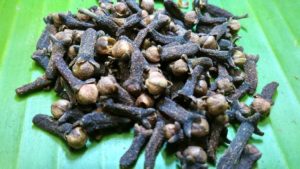
Dried clove buds
Cloves are the dried flower buds of clove trees (Syzygium aromaticum) which were originally found on the so-called Spice Islands of Indonesia but have since been spread to tropical areas around the world such as India, Madagascar, and Tanzania to name a few. These spicy buds have been incorporated into the cuisines of Asia, Africa, the Middle East, Europe and Mexico. In Indonesia, they are smoked in clove cigarettes.
Cloves are used in traditional medicines such as Ayurvedic and Chinese medicines. In Europe and the Americas, the essential oil has been used as a painkiller for dental procedures. Diluted clove oil is still rubbed on the gums of babies who are teething.

Orange pomander
During Victorian times, cloves were used to decorate oranges, called pomanders, and were given as gifts.
Clove trees are tropical plants hardy in growing zones 10 & 11. They grow best in rich, loamy soil, preferably in partial shade. At maturity they can reach a height of 40 feet tall. They require a lot of humidity and large amounts of rainfall, between 50 and 70 inches each year. Obviously, clove trees are not suitable for container growing.
Cloves are easily grown from seed, but it has to be freshly harvested seed.
The trees don’t start producing flowers until they are 20 years old. Once they begin making flowerbuds, they are harvested twice a year by hand when the buds turn from green to pink. After the buds are harvested, they are spread on the ground to dry in the sun for 4 to 6 days. The buds are fully dried when they are a dark brown and weigh one third as much as when they were picked. Dried buds should be stored in tightly sealed containers. Exposure to moisture will cause them to rot.
Each tree can produce up to 75 pounds of buds each year for decades. It is said that clove trees can live for more than a century.

